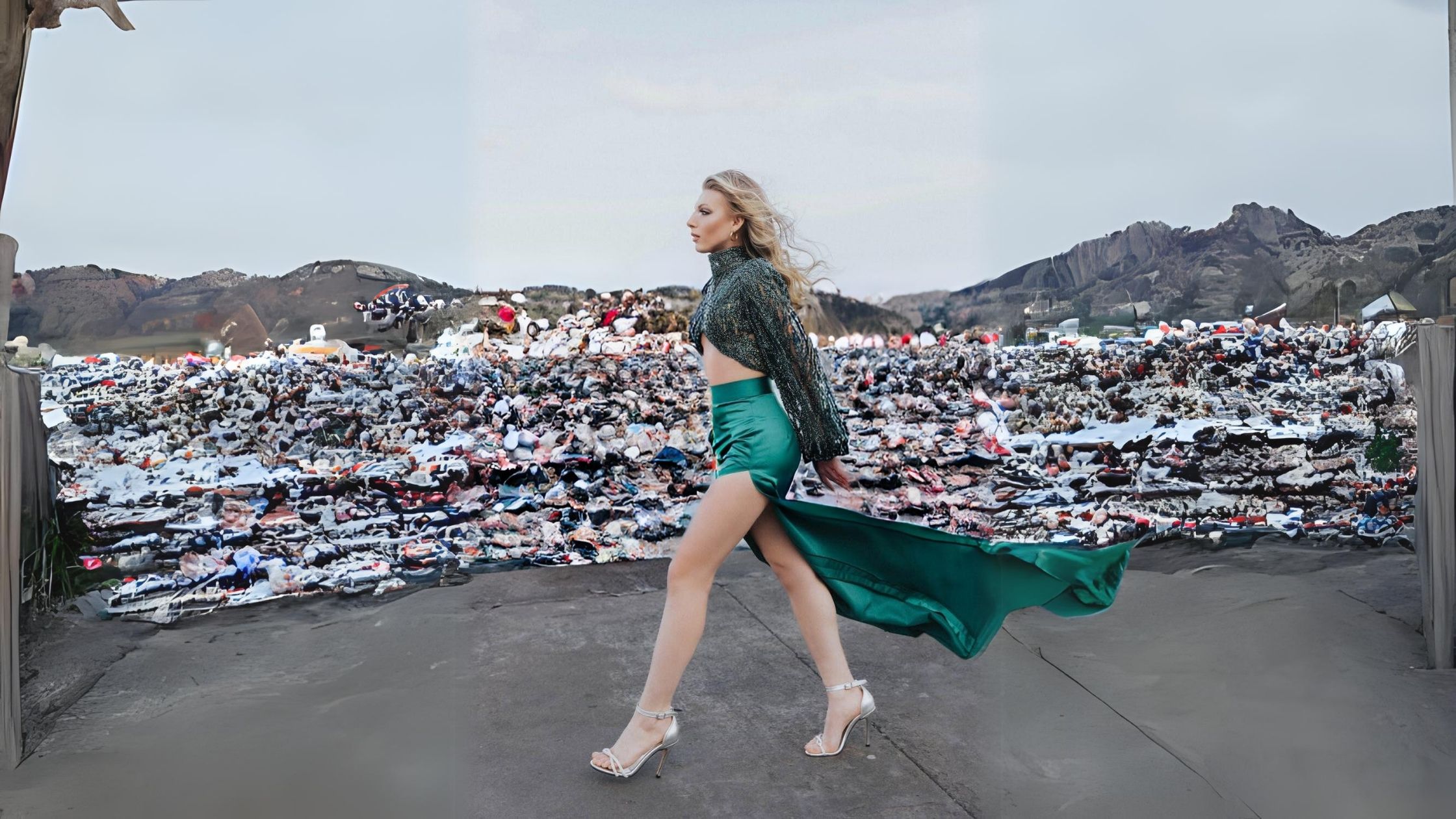Adding to a cart is one of the most fulfilling clicks in most of our lives. Especially when there is a 70% off sale on Shein, and with Black Friday coming up in a few short weeks, fashion brands like H&M and Zara will be sure to give the people what they want – clearance sales, and major discounts. The holiday season means new outfits to buy, and matching family sweaters to seek out – clothes have always been such a primal part of the celebration, but also everyday life.
But how often do we really stop to think before clicking “Add to Cart?” Serious questions like – how is this brand offering such a huge percentage off for the holiday season and still making profits? If they are not making profits, then why are they running their business? If they are making profits even after those significant discounts, how cheap are these clothes? What is the secret behind such low prices of these clothes – are the materials used in these clothes cheap or low-quality? If these materials are below quality, how long will we be able to use them – is it a good investment? What will happen to these clothes made from low-quality materials after we won’t be able to use them anymore? If the materials are not low-quality, then how come the prices are so cheap? If you are someone who thinks these are serious or at least interesting questions to be asked, then you are in the right place. It’s time to learn about fast fashion before clicking “Add to Cart” this holiday season. So, buckle up and brace yourself.

What is fast fashion?
Fast fashion is a phenomenon that has been noticed over the past 30 years, one that spread globally and quickly. According to the UN, fast fashion is a business model “of quick turnover, high volume, and cheap prices.” It is basically where fashion brands – to keep up with current trends and styles – mass produce their items at a low manufacturing cost to supply high demand. Fast fashion has been a booming industry since the late 1900s and the early 2000s, and these retailers include Zara, H&M, and Shein.
What customers usually notice is that clothing items in fast fashion brands are relatively cheap, with a magnitude of vast options.
Why does fast fashion exist?
Shopping for clothes was once considered an event. This means that people would save up throughout the year and purchase new clothes at specific times. Style-conscious people would be well aware of the latest trends and designs through the fashion shows that showcased clothing pieces months before they were available in stores. People were used to shopping for clothes once or twice per year, in the regard that it was an occasion.
However, in the late 1900s, that began to change. Shopping quickly changed into a form of entertainment and leisure, which consequently meant that people bought clothes more often, at a higher pace. This was what set off the concept of fast fashion – retailers could mass-produce clothing pieces at low prices, which made consumers feel they were up to date with the latest trends in real time. Fast fashion items were never made with the intention of lasting multiple years or wears – its goal was to manufacture cost-effective clothing directly satisfying the shifting demands of the consumer.

The fashion industry is one of the largest working industries globally, with a value of 2.5 trillion dollars, providing employment for over 75 million people worldwide, as stated by UNECE. In theory, and from pure definition, fast fashion sounds harmless – a company is mass-producing clothes, for a cheaper price, which people can afford. If anything, this can be seen as a strategy that grants people easier access to clothes due to their affordable price. However, the consequences of fast fashion are ones that aren’t easy to notice, but hard to ignore. Fast fashion directly contributes to waste colonialism and exploitive labor practices – which consumers are unaware of during their purchases.
How does fast fashion negatively affect the environment?
Alright, so what about clothes during the holiday season? According to USA Facts, clothing, and accessory retailers have the highest jumps in sales during the holiday season. Statista found that in 2022 47% of Gen Z purchased new fashion items for themselves to wear on Christmas, while Millennials were at an astounding 50%. This shows that there is a high intent for purchase and paired with the high discounts available in fast-fashion brands, it explains why people tend to buy more new clothes during the holiday season. Since fast fashion utilizes low-quality fabrics, that means the clothes purchased during the holiday season would have a life span of only a few months – and when that life span is over, people do what they always do when something has served its purpose – they throw it away.

Fast fashion relies on a business model that depends on “recurring consumption and impulse buying, instilling a sense of urgency when purchasing.” This business model has clearly succeeded, with global consumption rising to 62 million tons of apparel per year, and by 2030, it is expected to reach 102 million tons.
Fast Fashion’s Global Impact
The Ellen Macarthur Foundation – a UNEP partner – estimates that a truckload of abandoned textiles is discharged into landfills or incinerated every second. This is why it is estimated that people are buying 60% more clothes and wearing them for half as long. According to The Business Insider, 85% of all textiles go to dumps every year. The textiles in landfills have the capacity to contaminate soil. Countries such as Uganda, with high rates of agriculture and farmers, export contaminated food and resources to other countries. This can lead to major health risks and dangers, alongside negative side effects to animals and plants in their ecosystems.
This means that fast fashion contributes directly to waste colonialism. Most fast fashion exports are from developing countries across Asia, including India, Bangladesh, Vietnam, China, Indonesia, Cambodia etc. This means that the Global South is not only the one with the highest production of fast fashion but is also the one that suffers its consequences the most after it gets thrown out. The BBC reported in 2022 that more than half of the clothes imported to Chile end up in the Atacama Desert. On Jamestown Beach, located in Accra – Ghana’s capital – you must walk between mountains of shoes, pants, and tattered t-shirts. These used textiles come from Western countries and Asia to be dumped and dealt with in Ghana.

These discharged textiles contribute to microplastics found in the water, which can then affect marine food chains – which means that the Ghanaian people eat contaminated fish. Discharged textiles are often brought into the Global South without warning, leaving them to deal with methods to get rid of these clothes. Because the quality is so low, merchandisers can’t even sell discharged textiles – therefore, it is another burden of waste that they are responsible for getting rid of, or facing the consequences it brings – most of the time, it is both.
Fast Fashion and Climate Change
Besides the littering and waste of fast fashion, it directly affects global warming. Producing clothes requires natural resources, which emit greenhouse gases. According to the UN, the fashion industry is responsible for 8-10% of global emissions, surpassing aviation and shipping industries combined. The World Bank suggests that global clothing sales are to increase to 65% by 2030. A higher percentage in global sales indicates more discharged textiles to deal with – putting even more pressure on the Global South to manage the waste provided by the Global North.
Consumer Awareness
Some may argue that the average consumer isn’t aware of the negative connotations that come with fast fashion. According to Nayab Sohail, a Pakistani Slow Fashion ambassador, consumers must be educated about the issues fast fashion causes. Once consumers are educated on the link between fast fashion and climate change, that would allow for a change in their approach towards fast fashion. Merlina Carolina, the Global Creative Lead of the Slow Fashion Movement and founder of Slow Fashion El Salvador, believes that the average consumer is “so caught up in routine and system that they probably don’t have the energy to question or consciously think about how the environment works.”

Others argue that consumers are aware – to a small degree – of the link between fast fashion and the environment. Grace Kemp, another ambassador of the Slow Fashion Movement, believes that a “majority of people” are aware of the impact fast fashion has on the environment. Kemp claims that because of the sudden uprise of “green” campaigns in recent years, this must correlate to the level of awareness existing amongst consumers.
How can you reduce your fashion footprint?
Kemp mentioned how people might be aware of the negative link between fast fashion and the environment; however, they feel as though “it is too big for them to be able to do anything, so they carry on.” The typical solution to fast fashion has always been slow fashion. But slow fashion brands are usually expensive – the biggest disadvantage that fast fashion solves.
Even then, there are solutions to fast fashion that don’t necessarily have to break the bank. Karen James Welton, a slow fashion stylist, advises to wear what you own. Purchasing clothing pieces for the sake of a current, temporary trend usually means it won’t be worn again. Welton also advises shopping vintage and second-hand. Swapping clothes with your family members and friends, or borrowing clothes isn’t shameful in any way – it is a direct solution to make sure you aren’t buying too many clothes. Kristīne Čeirāne, an ambassador’s coordinator of the Slow Fashion Movement, says, “The most sustainable wardrobe is the one people already have. Look after your clothes and wear them for as long as you can. The greenest purchase is the one you didn’t make.” Welton also recommends that for new purchases, you save up for investment pieces that you will be able to wear for years. Timeless, classic pieces that will always look good regardless of the current trend going around.

A Joint Effort for a Sustainable Future
The solution to fast fashion isn’t reserved for individual consumers only. The UN initiated the #ActNow Fashion Challenge, which aims to show individuals and industries how to improve the environmental impact that fashion leaves. Limiting and decreasing the carbon footprint that the fashion industry leaves is a key factor in reducing global warming, which is why NGOs have pointed out fast fashion’s harmful business model. Greenpeace and other groups have urged the sector to slow down the trend of mass-producing clothes that are thrown away so quickly. In COP-27 in Egypt, the fashion sector did promise a net-zero carbon footprint, but giant clothing retailers still struggle to manage their own emissions, considering the high demand for fast fashion now.
It is essential that there is a joint effort – between the consumer and the industry – to work towards a less wasteful, more sustainable style of fashion. Looking good and trendy shouldn’t have to come at the cost of the environment. There is work towards sustainable fashion, and as long as there is work, there is always a way.
The holiday season doesn’t need to be ugly for everybody. You can still look wonderful in the clothes you have – maybe styling it differently will give it a new look! Remember the consequences of clicking “Add to Cart” from a fast fashion brand – no one should spend their holiday season struggling through mountains of discharged clothes for the sake of fashion.







